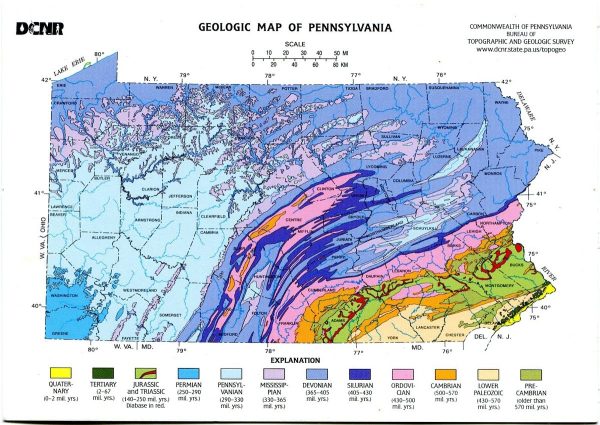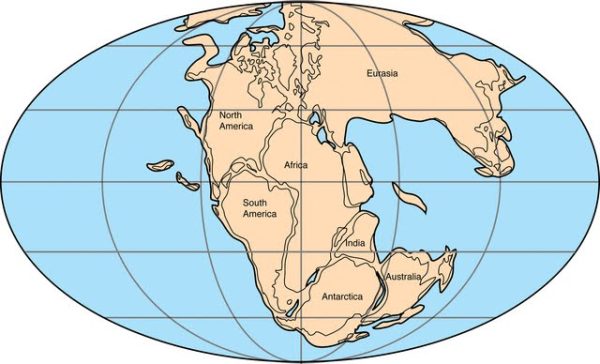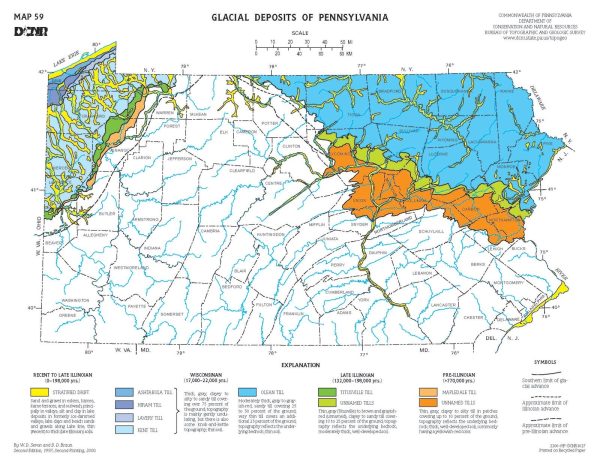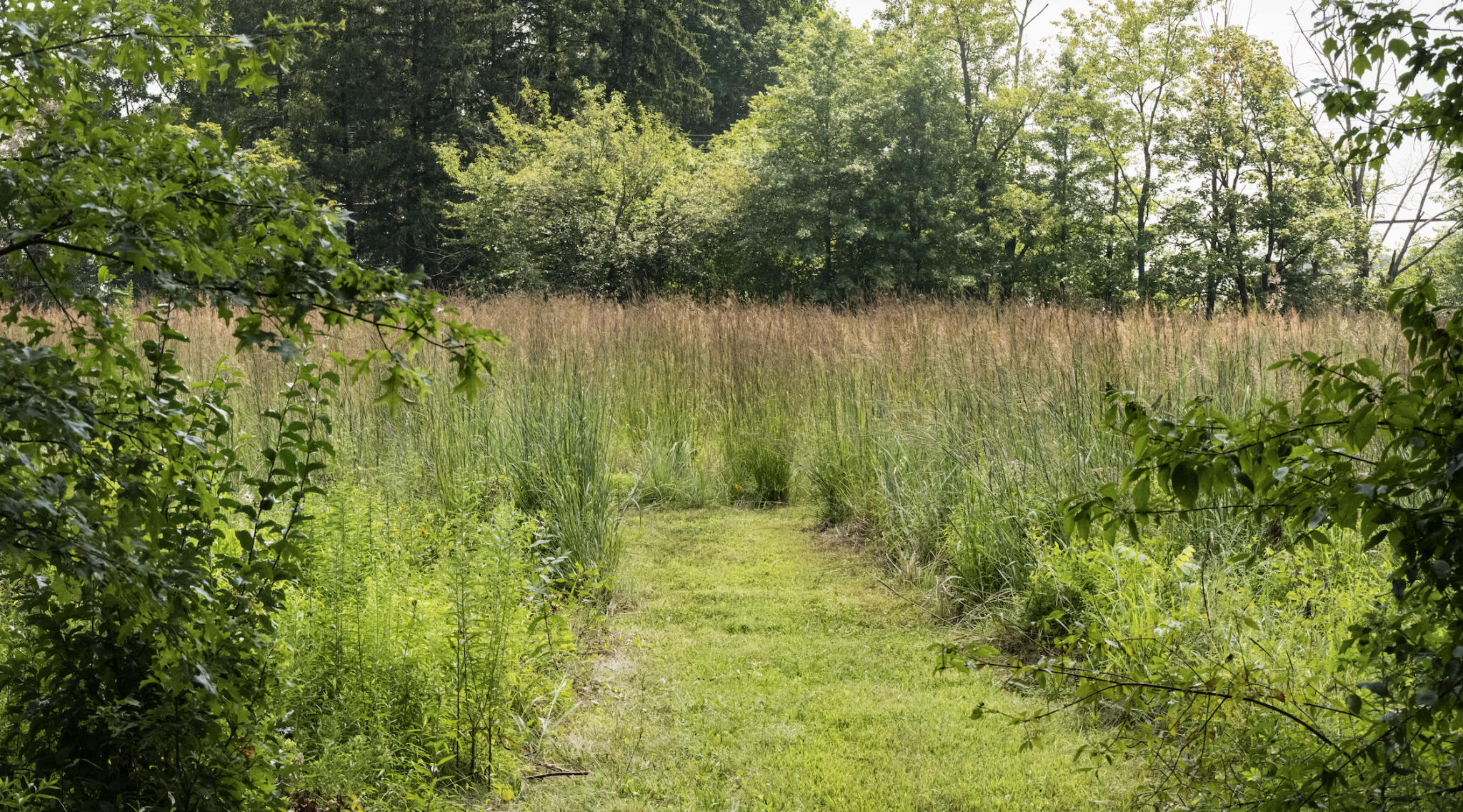4.6 billion years is a long story to tell within a human lifetime, let alone a single article, yet here I am trying to sum up PA’s place – southeastern PA in particular – in Earth’s history in roughly 2,000 words. Why? Because I’ve found that understanding our place in the world of rocks builds a greater appreciation for what we have today.
The driving force behind the plot of geologic history on this planet is Earth’s hot, heavy-metal core and surrounding molten mantle. Earth is so massive that the pressure at the center of the Earth created by gravity releases a lot of heat energy. Without that heat, Earth’s surface would be stagnant like that of the moon, disturbed only by outside forces like meteor strikes. With the heat, we get the movement of tectonic plates, volcanic eruptions, and smaller displays like geysers and hot springs. The products of this activity are then further shaped and modified by the forces of wind and water, powered by the uneven heating of Earth’s surface by the sun, the spin of the planet, and the pull of the moon. The result is an ever-changing surface on this planet for life to adapt to, and an epic history to tell.
Extremely Old
The first couple billion years of Earth’s history are so ancient and chaotic that it would be exceedingly hard to pinpoint Pennsylvania within it. So instead, we’ll pick up the story 2 to 3.5 billion years in. Pennsylvania is located on the North American tectonic plate, unsurprisingly, but outside of the “Laurentian craton” aka the part of the plate that has been stable since its formation 2.5 to 1 billion years ago. In other words, Pennsylvania’s geology has undergone major changes as mountain-forming collision periods alternate with ocean-forming spreading periods since the creation of tectonic plates. When our plate formed, it was a part of the equatorial supercontinent known as Rodinia, life was just starting to experiment with being multicellular, and carbon-dioxide-loving algae were thriving in the warm waters, but creating an evermore oxygen-rich and cooler atmosphere.

But Rodinia, like all supercontinents, rifted apart over time with the first splitting coming around 735 million years ago, and a second around 570 million years ago. This spreading lowered elevation in Pennsylvania and the rest of today’s east coast, which resulted in the creation of the Iapetus Ocean as water filled in, bringing with it eroded sediments that accumulated on the new ocean’s floor. I say “today’s east coast,” because at that time the land mass was oriented so that what we call east was facing south. Furthermore, this land was much closer to the equator. From here on, however, I will talk about direction relative to today’s orientation, unless otherwise specified.
Really, Really Old
Twenty-nine million years into the Iapetus Ocean’s formation, the Cambrian Explosion launched biological life into unprecedented diversity of species with unprecedented body forms and life styles. Trilobites (cousins of horseshoe crabs), and brachiopods (little clam-like critters) were among these new animals who would have lived on and in the steadily accumulating ocean sediments of Pennsylvania, particularly the sandier, shallower, more carbonate-rich sediments of now western PA. Eastern PA was under deeper water and as a result, received muddy clay sediments, until the late Ordovician period, roughly 80 million years after the Cambrian Explosion. By the end of the Ordovician, the Earth was warm and mostly covered in oceans, much of which was quite shallow (imagine walking into ankle deep water in Wisconsin, and continuing on to Texas before your head would be underwater). The diversity of species has tripled since the Cambrian period in what is known as the Great Ordovician Diversification, or “Diversity’s Big Bang,” with creatures like eurypterids (sea scorpions), and cephalopods (nautilus and the ancestors of octopus and squid) ruling the oceans.

The 10s of millions of years of Ordovician speciation was interrupted by one of the first Mass Extinctions. A Mass Extinction that was likely caused by events along eastern PA and the rest of the east coast. Volcanoes are born when superheated plumes of mantle basically punch a hole in the Earth’s crust. These plumes of superheated mantle move over the millenia, and by the late Ordovician, one such plume created a massive chain of enormous volcanoes from Newfoundland to Alabama including the eastern side of current day PA. Volcanoes so big their eruptions could likely be heard around the world. These volcanoes lifted up the ocean floor and ejected magma which cooled into igneous rock. Volcanoes are responsible for releasing carbon from rocks, like carbon-rich limestone, into the atmosphere. The result of that carbon release is a greenhouse effect. But once the volcanoes stop spewing, the igneous rock volcanoes leave behind is very reactive to chemical weathering, a reaction that pulls carbon dioxide out of the atmosphere. As the mantle plume shifted again over time, the active volcanoes cooled into the Taconic Mountains, an early contributor to our Appalachian Mountains. These mountains slowly weathered and eroded into the remaining ocean that still covered most of PA, a process that dramatically cooled the Earth’s atmosphere and triggered Earth’s first ice age. Global temperatures dropped, and ice accumulated on the supercontinent Gondwanaland (a combination of Africa, South America, India, and Australia), then located at the south pole. This accumulation of ice on land dropped sea levels so significantly that those expansive shallow oceans where life thrived dried up almost entirely. With much reduced habitat, and no migratory escape route available, roughly 86% of species went extinct.
The Ordovician period gives way to the Silurian and all the while our tectonic plate begins to rotate towards its current orientation. The Silurian period saw continued mountain erosion, now with sandy, quartz-rich sediments being deposited in eastern PA while muddier sediments landed in western PA. This is the period when PA’s iron deposits accumulated. Today, you can see places where this iron ore was extracted at Mine Hill and Rattlesnake Hill in Durham Township, Bucks County. The Iapetus Ocean over PA, NY and OH continued to shrink, more and more cut-off from other parts of the ocean. At that same time, early fish evolved proper jaws, scales and stronger fins, and plants evolved the ability to take root on land.
Quite Old
Jumping forward to roughly 380-360 million years ago, giant insects and other arthropods dominated the land while the first amphibians were experimenting with lungs. It is the end of the Devonian period. Pennsylvania finds itself once again bordered by mountains to the east. This time the mountains were the result of Europe’s tectonic plate colliding with that of North America. Known as the Acadian Mountains, these too eroded with time, layering their sediments on top of those left by the Taconic Mountains. Only now the shoreline has been pushed much farther west by in-filling, with most of PA above sea level. The new sediments, rather than ending up at the bottom of an ocean, became terrestrial soils exposed to air and oxidation in the then dry climate. These are the sediments that are transformed by time and pressure into the Marcellus shale.
The foundations for Pennsylvania’s modern-day fossil fuels continue to be laid into the Carboniferous period. As the Carboniferous kicked off, Pennsylvania’s climate got wetter and milder, still located around the equator. The waters of a second ocean crept back and forth across the land over the next 60 million years. Starting in southwestern PA, marine waters spread further inland across the mostly flat land, creating peat swamps at the edges. These swamps would then get buried by alluvial floodplain sediments coming from the north and east, pushing the marine waters back, before subsidence let the waters retake ground. Back and forth, the swampy coastline moved across Pennsylvania. Time, pressure and heat transformed the buried remains of lycopsids (scaly-barked trees), ferns, tree ferns and other organisms into coal seams.

Pennsylvania’s swampy flatness was dramatically altered 299 million years ago when the African continent collided with North America. Eastern PA was compacted, tilted and elevated in the biggest mountain-creation event yet, forming the Alleghanian Mountains (confusingly, not the same mountains as today’s Allegheny Mountains). Taller than the Taconic and Acadian mountains that pre-date it, the force of this collision compressed and tilted the existing bedrocks. Today’s Appalachian Mountains are essentially the remnants of the foothills of the Alleghanian Mountains. This continental collision was one piece in the puzzle of Pangea’s formation. The Pangea supercontinent lasted for roughly 80 million years. No longer bordering an ocean, Pennsylvania’s climate dried out. Globally, habitats like shallow oceans and wetlands became rarer, which favored the evolution and proliferation of reptiles whose hard-shelled eggs could be laid on dry land, unlike those of amphibians.

North America and Africa were torn apart roughly 220 million years ago during the late Triassic, powered, like all tectonic movement, by the mantle’s currents. The Atlantic Rift Zone and the ensuing Atlantic Ocean split Pangea in two, with North America and Eurasia on one side (the Laurasia supercontinent) and Africa, South America, India, and Australia on the other (the Gondwanaland supercontinent). The spreading plate movement created deep rift basins parallel to the central seafloor spreading. Each rift basin marks a weak point, or fault, where the central spreading seam could have been located. One such basin is the Gettysburg-Newark Rift Basin which stretches between its namesake cities. Had the fault that created the Gettsyburg-Newark Rift Basin been weaker, Philadelphia and Delaware County, along with most of Chester, Lancaster and York Counties may have ended up in Africa, rather than North America. The resulting basins were filled by sediments and sometimes large lakes during wet periods. The hot mantle current forcing the plates apart also creates volcanoes and magma intrusions in both the central rift and the parallel rift basins as magma finds fissures that allow it to reach the surface. The resulting igneous rock is known as diabase, a hard and dark-colored rock. You can see this Triassic-Jurassic diabase for yourself at Heritage Conservancy’s Quakertown Swamp Nature Preserve, or on public lands like Haycock Mountain State Game Lands and Ringing Rocks County Park. By this point in Earth’s history Pennsylvania is significantly north of the Equator bordering on the subtropical zone rather than the tropical zone. North America’s movement northward would continue. Today, the Atlantic Rift Zone continues to widen the Atlantic Ocean by about an inch every year.
OLD old
The Mesozoic Era ends with the meteor-strike in the Yucatan peninsula that wiped out most of the dinosaurs roughly 66 million years ago, ushering in the Cenozoic Era and the rise of mammals. About 20 million years ago, the North American plate was tilted slightly differently than it is today. The east coast was at a slightly lower elevation which brought the Atlantic Ocean’s shore to southeastern Bucks, Montgomery and Delaware counties. New sandy, gravelly deposits accumulated as rivers emptied into the ocean. These sediments were then exposed and turned into soil as the continental tilt shifted, elevation rose and the waters retreated, resulting in the distinct soils (and therefore vegetation communities) of the Atlantic Coastal Plain. Over the course of 800,000 to 24,000 years ago, glaciers repeatedly advanced from Canada all the way into northwestern and northeastern Pennsylvania, scraping away soils, gouging deep valleys, knocking off mountain tops and leaving enormous boulders in their wake. Rocks and sediments displaced by glaciers flowed downstream and were deposited in places like southern PA. This most recent Ice Age didn’t have the same Mass Extinction effect as that at the end of the Ordovician period, which may be attributed to the current north-south orientation of the continents. The Americas in particular cover just about every latitude from the South Pole to the North Pole, which allows species to migrate and follow their preferred climate as the planet gradually shifts from cold periods to warm ones. We’ve observed that range migration phenomenon over just the past several decades as plants and animals respond to human-caused climate change, but the rapid rate of change combined with habitat fragmentation created by development introduces new challenges to this adaptation strategy.

Now
The last glacier’s retreat marks the end of the major transformations in Pennsylvania’s geological history to date. Since then, humans have certainly altered the geological landscape, largely through mining. Seemingly “natural” features like Lake Galena at Peace Valley Park and Bowman’s Wildflower Preserve, in Bucks County and Valley Forge National Historic Park in Chester and Montgomery Counties are in fact the products of historic lead-sulfur, copper, and limestone and magnesium mining operations respectively that have since been intentionally naturalized.
Throughout southeastern PA, rocks born of wildly different time periods are brought together. You can stand at one of these meeting points at the Monroe Border Fault, a spot near the intersection of Route 611 and Lehnenberg Road where the Triassic Border Fault is marked with a plaque. Standing there, the rocks to the south were formed from Triassic-Jurassic sediments and magma, while those to the north are metamorphic granites and gneisses of the Precambrian. On the opposite side of the Triassic-Jurassic Lowlands, the Graystones of Morrisville mark another point of convergence where a quartzite formation from the Pre-Cambrian separates the young Atlantic Coastal Plain from the Gettysburg-Newark Rift Basin of the Triassic-Jurassic.
Key Takeaways From Pennsylvania’s Place in Earth’s History
- The Pennsylvania of today may feel tame, but a history of drama and chaos lies just beneath the surface.
- Next time you are driving past a cliff cut by the Delaware River or a highway, take a second to appreciate the glimpse back through deep time.
- Life is impressively resilient, but only if the physical environment provides a window of opportunity for adaptation.
- We need to be intentional about leaving those windows open. Life adapted to the most recent climatic changes by migrating. Creation, conservation and maintenance of migration channels and large contiguous habitats is vital to preventing mass extinction today. Check out The Nature Conservancy’s work on the Resilient and Connected Network of Landscapes to see how conservation scientists understand PA’s role in the response of plants and animals to modern climate chaos.
- Yes, we are small, but small creatures are very capable of catalyzing major changes to the Earth’s systems.
- I can’t help but feel humbled by the enormity of space and time when learning about geology and Earth history. I also can’t help but feel worried about the legacy that humans will have in this history.
Katie Toner, Conservation Easement Steward
Curious about pollinators, turtle crossings, reforestation and other woodsy things? Read more Nature Notes.
